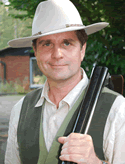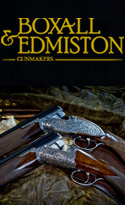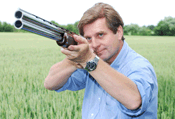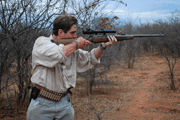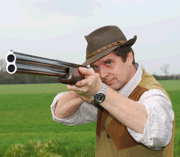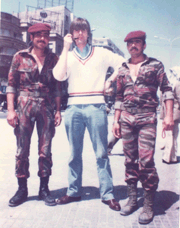Grip - How to Hold a Shotgun
Holding the gun may sound a simple topic, but it is amazing how many shots hold their gun in a way which impedes their shooting or is actually unsafe. The hands control the gun, if they do so efficiently purchase is maximised, recoil minimised (the hands absorb far more recoil energy than many realise) and the muzzles will be pointed effectively. A well designed gun, one with forend and grip which are well shaped and which have effective gripping surfaces, is an important part of the equation. I have picked up some guns which even the greatest stylists would have a job shooting well. No-one can hold a gun properly if the grip causes the hand to slip in recoil because it has been narrowed excessively to its front. A relatively even grip depth is required to get a good hold. Similarly, the forend and grip must not be greatly different in size, a thin grip is not well complimented by a thick forend and visa versa.
My own preferences are for grips which are fairly even in depth, fuller than average and symetrical. The Browning super-posed has an excellent grip, for example. On a side by side with twin triggers, nothing works as well as a straight grip, provided it is not too thin. Nor should it be too round in cross-section. Many semi-autos have grips which are too short in length and too square in cross section. They can be significantly improved just by checkering the area to the front of grip. Half-pistol grips deserve to be more popular on over and unders and semi-autos intended fro skeet, sporting or field use. The half pistol grip is usually good ergonomically and does not tend to check the swing as some full pattern grips may. As far as forends are concerned, my favourite on a sporting over an under is a well shaped snabel (as both Browning and Beretta have perfected over the years) or a rounded 'beaver-tail' of constant width and depth, fully chequered without finger grooves (these are rarer, but Beretta have made them and Perazzi will make you one if you ask for it specifically). I do not like Tulip forends - a short snabel with a swollen belly - on over and unders (because the hand is forced into a single position) or those forends which are very wide or very narrow. For side by sides there is little to beat the traditional 'splinter' style. Any beaver-tail fored on a side by side should be subtle or the gun will feel unbalanced. My own opinion, is that it is a mistake for the front hand to be moved to far away from the axis of the barrels.
Both hands should work together when we shoot. Is especially important that the rear hand does not dominate. It should maintain a comfortable grip with the web of the hand to the right of the topside of the grip (assuming a right-hander). Many adopt a rear grip with the web of the hand positioned too high. This creates unwanted tension and hinders the mount. Correct positioning of the rear hand ensures that the elbow falls into a comfortable position and that the trigger finger may be extended without twisting. Where should the trigger finger make contact with the trigger? I prefer to use the pad of the trigger finger, rather than the first joint as sometimes advocated. This is the most sensitive part of the finger and encourages a consistent pull rearwards without lateral stresses. Another point worth making with regard to the rear hand is the position of the thumb, it must not 'ride' the safety catch (which invites a painful injury) but should be well wrapped around the grip unless actually in the process of operating the safety.
Front hand position
If the hand comes too far back speed of swing may increased but control diminished. The opposite is true if the hand is extended excessively forward (as the British King, George V, used to do when pheasant shooting). Control is increased, but the swing may be checked if the front hand is placed too far forward. Try it. Pick up a gun, prove it empty, and engage an imaginary over-head bird with the front hand variously positioned. Do the same for crossing targets. An exaggerated forward hold makes both types of target significantly more difficult (and may lead to misses behind). It also restricts the ability of the front arm to keep the barrels up on line on quartering and crossing shots. A far better position is a naturally comfortable one with the front hand positioned about half-way up the forend of over and unders, at the tip of the forend of side by sides, or towards the rear of the forend on repeaters.
Some choose to extend the index finger of the front hand as an aid to pointing, for others this is uncomfortable. I tend to half-extend the index finger which has pointing advantages without tension. What is certainly wrong, is to allow any of the fingers to obscure the view of the rib (unless one is using the left thumb deliberately as a 'thumbstall' as Robert Churchill used to do to block vision to the left eye). Another horrible habit is what might be called the 'claw' grip, in which the hand is brought to the side of the forend (reducing support) with the index finger pointing above the axis of the barrels.
The front hand should not be twisted excessively as it grips the forend, and, as with the rear hand, a good front hand position encourages the front elbow to fall into a natural unstrained position. What about grip tension? Neither hand should have a white knuckle grip. Opinions vary beyond that. D. Lee Braun, a fabulous shot and one of the USA's most respected instructors who used to say that one should grip the forend "as if holding a handful of eggs". Some might say that was not hard enough, but it makes the point that if there is too much tension movement may be restricted. First class shots, even those who are very powerfully built, always seem hold their guns with finesse and a certain delicacy, facilitating fine control of the tip of the gun.


